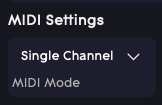Here we will go through how to assign the Seaboard 2's 5D touch to any parameter in Ableton's built-in instruments. There are differences in setup when using MPE or not, so feel free to head to the section that interests you first.
We're going to use Slide as an example in this guide. Mapping Slide is pretty straightforward and you can either manually assign this in your VST or achieve it through Ableton's MIDI mapping.
TABLE OF CONTENTS
Mapping Slide in MPE instruments
For MPE instruments like Sampler, we can do this within the instrument itself.
Back in Ableton, add Sampler to an empty MIDI track. Drop a sample of your choice into the sample area. Here I've used a simple sawtooth wave and set it to loop.
Now let's make Slide open and close the filter. Open the MIDI tab in Sampler, find the Pressure mapping section and choose 'Filter Freq' from the drop-down list. Set the range to 100.

Mapping other the 5D touches
You can apply this method to any of the other 5 dimensions of touch. In the MIDI tab, Ableton refers to each touch as follows:
Velocity = Strike
Note PB = Glide
Slide = Slide
Pressure = Press
Off Vel = Lift
Just repeat the steps above for any of these to create your own customized MIDI mapping for all 5 dimensions of touch.
Mapping Slide in non-MPE instruments

Now you'll be able to open and close the filter using Slide.
Adjusting the Slide mode
Feel free to change the Slide Mode in Dashboard for different ways of using Slide. For example, in Absolute mode, the precise position on the keywave affects the sound - e.g. the whole keywave's vertical axis will have a different value. In the Relative modes, the sound will only change when moving your finger up or down on the keywave.
For more information on this, see the article: Slide: Absolute vs. Relative
